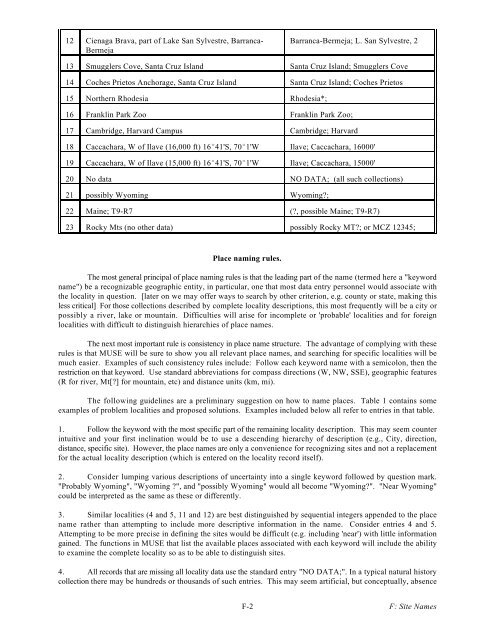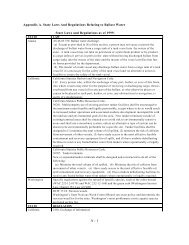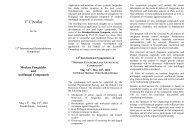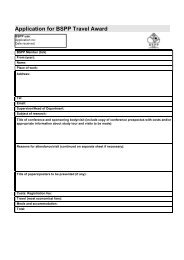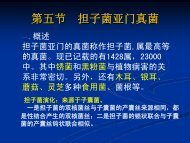You also want an ePaper? Increase the reach of your titles
YUMPU automatically turns print PDFs into web optimized ePapers that Google loves.
12 Cienaga Brava, part of Lake San Sylvestre, Barranca- Barranca-Bermeja; L. San Sylvestre, 2<br />
Bermeja<br />
13 Smugglers Cove, Santa Cruz Island Santa Cruz Island; Smugglers Cove<br />
14 Coches Prietos Anchorage, Santa Cruz Island Santa Cruz Island; Coches Prietos<br />
15 Northern Rhodesia Rhodesia*;<br />
16 Franklin Park Zoo Franklin Park Zoo;<br />
17 Cambridge, Harvard Campus Cambridge; Harvard<br />
18 Caccachara, W of Ilave (16,000 ft) 16 41'S, 70 1'W Ilave; Caccachara, 16000'<br />
19 Caccachara, W of Ilave (15,000 ft) 16 41'S, 70 1'W Ilave; Caccachara, 15000'<br />
20 No data NO DATA; (all such collections)<br />
21 possibly Wyoming Wyoming?;<br />
22 Maine; T9-R7 (?, possible Maine; T9-R7)<br />
23 Rocky Mts (no other data) possibly Rocky MT?; or MCZ 12345;<br />
Place naming rules.<br />
The most general principal of place naming rules is that the leading part of the name (termed here a "keyword<br />
name") be a recognizable geographic entity, in particular, one that most data entry personnel would associate with<br />
the locality in question. [later on we may offer ways to search by other criterion, e.g. county or state, making this<br />
less critical] For those collections described by complete locality descriptions, this most frequently will be a city or<br />
possibly a river, lake or mountain. Difficulties will arise for incomplete or 'probable' localities and for foreign<br />
localities with difficult to distinguish hierarchies of place names.<br />
The next most important rule is consistency in place name structure. The advantage of complying with these<br />
rules is that MUSE will be sure to show you all relevant place names, and searching for specific localities will be<br />
much easier. Examples of such consistency rules include: Follow each keyword name with a semicolon, then the<br />
restriction on that keyword. Use standard abbreviations for compass directions (W, NW, SSE), geographic features<br />
(R for river, Mt[?] for mountain, etc) and distance units (km, mi).<br />
The following guidelines are a preliminary suggestion on how to name places. Table 1 contains some<br />
examples of problem localities and proposed solutions. Examples included below all refer to entries in that table.<br />
1. Follow the keyword with the most specific part of the remaining locality description. This may seem counter<br />
intuitive and your first inclination would be to use a descending hierarchy of description (e.g., City, direction,<br />
distance, specific site). However, the place names are only a convenience for recognizing sites and not a replacement<br />
for the actual locality description (which is entered on the locality record itself).<br />
2. Consider lumping various descriptions of uncertainty into a single keyword followed by question mark.<br />
"Probably Wyoming", "Wyoming ?", and "possibly Wyoming" would all become "Wyoming?". "Near Wyoming"<br />
could be interpreted as the same as these or differently.<br />
3. Similar localities (4 and 5, 11 and 12) are best distinguished by sequential integers appended to the place<br />
name rather than attempting to include more descriptive information in the name. Consider entries 4 and 5.<br />
Attempting to be more precise in defining the sites would be difficult (e.g. including 'near') with little information<br />
gained. The functions in MUSE that list the available places associated with each keyword will include the ability<br />
to examine the complete locality so as to be able to distinguish sites.<br />
4. All records that are missing all locality data use the standard entry "NO DATA;". In a typical natural history<br />
collection there may be hundreds or thousands of such entries. This may seem artificial, but conceptually, absence<br />
F-2<br />
F: Site Names


